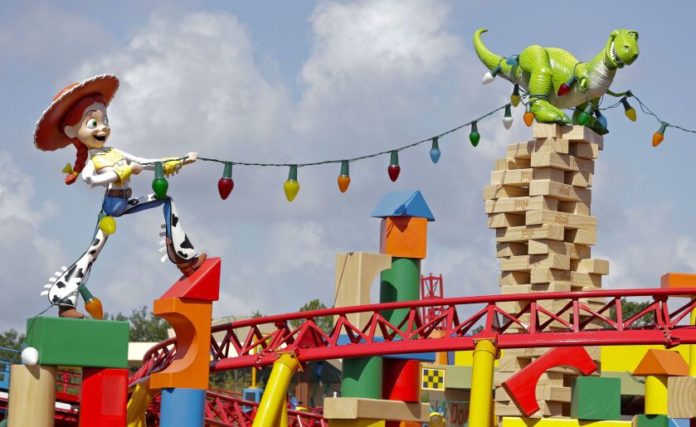After nearly three decades, four full-length films, seven affiliated shows and a spinoff film, “Lightyear,” released this past weekend, “Toy Story” is still warming hearts far beyond Andy’s childhood bedroom. It’s one of few Disney series to still have merchandise being manufactured and sold in the Disney Store. Disney’s Hollywood Studios includes “Toy Story Land,” an area centered around the series and its characters. And all four films hold at least a 90% audience score on Rotten Tomatoes (100% Tomatometer for three of the four).
From a business perspective, all four “Toy Story” films earned far more than what their production budget demanded and the third and fourth films still sit in the top three of Pixar’s films’ gross earnings in the worldwide box office, according to The Numbers.
But how did the Pixar team build a legacy with these films? How did “Toy Story” have such an impact on animators, writers and audience members that people return to the original film 27 years later?
Pixar, then known as “Lucasfilm’s Computer Division” and owned by George Lucas himself, was purchased by Steve Jobs in 1986. Up to that point, the group’s primary mission had been “developing state-of-the-art computer technology for the film industry,” not creating films, according to the Pixar website. It wasn’t until five years later — after the team had been working on Disney’s commissioned animation software, the “Computer Animation Production System” or CAPS — that Jobs would strike a deal with Disney to create a single, fully-animated film showcasing the new technology.
“Toy Story” became that film, and it was the first of its kind. While the Pixar team had experience in storytelling from working on their film shorts — “Tin Toy,” “Knick Knack” and “Luxo Jr.” to name a few — these “shorts” averaged a run-time of about four minutes. “Toy Story,” by comparison, would ultimately end up being 81 minutes long and it took four years to fully animate and polish, according to WIRED.
But Pixar had spent the decade prior working with Lucas to develop more advanced animation technology. Programs such as the “Pixar Image Computer” and “RenderMan,” would provide animators with software the “Toy Story” project demanded. A faculty member of the California Institute of the Arts, who wished to remain unnamed, shared his insight on the “Toy Story” team’s innovation with the Deseret News.
“‘Toy Story’ showed what was possible. It introduced some workflows, techniques and tools, and basically showed that if you can put your mind to it, you can do it. It showed what computer (animation) technology was able to handle by that point and it was only getting better,” he said.
But for all of Pixar’s progress in animation, the professor explained, there were still some standards and techniques in art that were unaffected by time or progress.
“‘Toy Story’ ended up being fairly seminal in that it was the first very successful feature and it helped set the bar for how things could and should look. But as far as visual storytelling, (3D animation) didn’t have much of an impact on the fundamentals,” the professor said. A film’s “story is its story, and design is its design.”
Since “Toy Story” was their first full-length film, the original Pixar “brain trust” — the five directors, animators and writers unofficially assigned to ensure quality and creativity for the project — were required to work very closely with Disney on the story of the film.
An academic paper on the film’s screenwriting describes how at one point in the development of “Toy Story,” Disney representatives sat down with Pixar for an initial story reel (storyboards set to vocal performances by the actors.) The original script of “Toy Story” was far darker than the final product, closer to being rated “R” than “PG.” At the end of that first presentation, Disney executives were appalled and completely halted production of the film. An ultimatum was given: if the Pixar team couldn’t create a better script, the movie would be canceled.
Following that meeting, John Lasseter and Pete Docter attended a writing seminar from screenwriting expert Robert McKee in 1992. It was in studying McKee’s writing methods that the Pixar team encountered a writing standard that would be used in “Toy Story” and in each of their films that followed. They learned to balance convention and innovation, according to Andrew Gay, author of the chapter, “The Cowboy, the Spaceman and the Guru: Character and Convention in the Screenwriting of Toy Story,” in the book, “Toy Story: How Pixar Reinvented the Animated Feature.”
Gay, who is also an associate professor of digital cinema at Southern Oregon University, explained the effect of drastically shifting the context in an otherwise realistic story in an interview with the Deseret News.
“There are a lot of other screenwriters and storytellers out there who have more inventive narratives, new genres, new structures. That’s not really what Pixar has done much of. What they’re getting so much ‘juice’ out of is that character perspective that we haven’t seen before,” he said.
Gay continued, “That’s where all the uniqueness comes from, it’s because they do good character work. They ask questions. … It’s not simply watching what a human would do as a toy, but actually asking, ‘What would a plastic astronaut toy do in this situation?’ They really drill down into the identity of each of these characters.”

In this Saturday, June 23, 2018, photo, the character Jessie pulls on a string of giant lights tangled around Rex the dinosaur at Toy Story Land in Disney’s Hollywood Studios at Walt Disney World in Lake Buena Vista, Fla.
John Raoux, Associated Press
Following additional rewrites and story reels with Disney, writer Joss Whedon worked alongside the Pixar brain trust to rebuild the movie’s script. The brain trust would see “Toy Story” finally being approved for production by Disney and in 1995, the world’s first computer-animated feature film was released.
“Toy Story” earned $362 million in the worldwide box office, and the following year, it was nominated for best original song, best original score and best original screenplay, according to Pixar. Additionally, in 1997, Walt Disney Studios agreed to produce five more movies in coordination with Pixar over the next decade.
Seth Holladay, associate professor at Brigham Young University and previous member of the Pixar visual effects team, told the Deseret News that Pixar’s success with “Toy Story” stems from the studio embracing new ideas while utilizing established technique, in both storytelling and animation.
“It’s important to be willing to dive into new things … and have a strong foundation to tell successful stories. What the original ‘Toy Story’ did well was that they were diving into new technology, which advances what you can create in your world. It really opened a lot of doors,” he said. “But they also stuck with the key elements of storytelling, and they were willing to rebuild ‘Toy Story’ over and over until they came up with something that was right. (New) technology doesn’t make things successful by itself, but it helps make the story possible.”
With even newer technology and a brain trust ready to assist, Pixar’s newest film, “Lightyear,” was projected to earn $75 million to $80 million in the box office opening weekend. Although the film has had a slow start after earning only $50.6 million over Father’s Day weekend, according to the Hollywood Reporter, big earnings could still be within reach.
Business Insider drew comparison to another Pixar film, “Coco,” as the film opened with a close $50.8 million in 2017. It went on to gross $210 million in the U.S. and $807 million worldwide, giving hope that “Lightyear” can still go to infinity and beyond.








